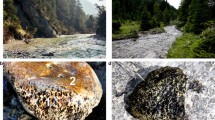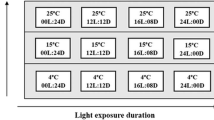Abstract
In this study, ten cyanobacterial strains assigned to the oscillatorian species Phormidium autumnale have been characterized using a polyphasic approach by comparing phenotypic and molecular characteristics. The phenotypic analysis dealt with cell and filament morphology, ultrastructure, and pigment content. The molecular phylogenetic analyses were based on sequences of the 16S rRNA gene and the adjacent intergenic transcribed spacer (ITS). The strains were quite homogenous in their morphologic features. Their thylakoids showed a stacked or fascicular pattern. Some, but not all strains contained phycoerythrin. Only one strain (P. autumnale UTCC 476) deviated significantly in its phenotype by lacking a calyptra. In neighbour-joining and maximum Parsimony trees most 16S rRNA sequences were located on a single well-defined branch, which, however, also harboured sequences assigned to other cyanobacterial genera. Two strains (P. autumnale UTCC 476 and P. autumnale UTEX 1580) were found on distant branches. The presence of phycoerythrin was not correlated with the strains’ position in the phylogenetic trees. Our results reconfirm that the morphospecies P. autumnale and the Phormidium group in general are not phylogenetically coherent and require revision. However, as indicated by sequence similarities most of the strains assigned to P. autumnale except P. autumnale UTCC 476 and P. autumnale UTEX 1580 are phylogenetically related and might belong to a single genus.





Similar content being viewed by others
References
Anagnostidis K, Komárek J (1988) Modern approach to the classification system of cyanophytes. 3. Oscillatoriales. Arch Hydrobiol Algol Stud 50–53:327–472
Bourrelly P (1970) Les algues d’eau douce, vol III. N. Boubée & Cie, Paris
Boyer SL, Johansen JR, Flechtner VR, Howard GL (2002) Phylogeny and genetic variance in terrestrial Microcoleus (Cyanophyceae) species based on sequence analysis of the 16S rRNA gene and associated 16S–23S ITS region. J Phycol 38:1222–1235
Casamatta DA, Johansen JR, Vis ML, Broadwater ST (2005) Molecular and morphological characterization of ten polar and near-polar strains within the Oscillatoriales (cyanobacteria). J Phycol 41:421–438
Cermeno P, Maranon E, Harbour D, Harris RP (2006) Invariant scaling of phytoplankton abundance and cell size in contrasting marine environments. Ecol Lett 9:1210–1215
Comte K, Sabacka M, Carre-Mlouka A, Elster J, Komárek J (2007) Relationships between the Arctic and the Antarctic cyanobacteria; three Phormidium-like strains evaluated by a polyphasic approach. FEMS Microbiol Ecol 59:366–376
Desikachary TV (1959) Cyanophyta. Indian Council of Agricultural Research, New Delhi
Fiore MF, Neilan BA, Copp JN, Rodrigues JLM, Tsai SM, Lee H, Trevors JT (2005) Characterization of nitrogen-fixing cyanobacteria in the Brazilian Amazon floodplain. Water Res 39:5017–5026
Fox GE, Wisotzkey JD, Jurtshuk P Jr (1992) How close is close: 16S rRNA sequence identity may not be sufficient to guarantee species identity. Int J Syst Bacteriol 42:166–170
Frémy P (1934) Cyanophycées des côtes d’Éurope. Mem Soc Nat Sci Nat Math Cherbourg 41:1–234
Garcia-Pichel F, Prufert-Bebout L, Muyzer G (1996) Phenotypic and phylogenetic analyses show Microcoleus chthonoplastes to be a cosmopolitan cyanobacterium. Appl Environ Microbiol 62:3284–3291
Garcia-Pichel F, López-Cortés A, Nübel U (2001) Phylogenetic and morphological diversity of cyanobacteria in soil desert crusts from the Colorado plateau. Appl Environ Microbiol 67:1902–1910
Geitler L (1932) Cyanophyceae. In: Kolkwitz R (ed) Rabenhorst’s Kryptogamenflora von Deutschland, Österreich und der Schweiz. Akademische Verlagsgesellschaft, Leipzig, pp 1–1196
Gleason F, Paulson JL (1984) Site of action of the natural algicide, cyanobacterin, in the bluegreen alga, Synechococcus sp. Arch Microbiol 138:273–277
Higgins D, Thompson J, Gibson T, Thompson JD, Higgins DG, Gibson TJ (1994) CLUSTAL W: improving the sensitivity of progressive multiple sequence alignment through sequence weighting, position-specific gap penalties and weight matrix choice. Nucleic Acids Res 22:4673–4680
Iteman I, Rippka R, Tandeau de Marsac N, Herdman M (2000) Comparison of conserved structural and regulatory domains within divergent 16S–23S rRNA spacer sequences of cyanobacteria. Microbiology 146:1275–1286
Kann E, Komárek J (1970) Systematisch-ökologische Bemerkungen zu den Arten des Formenkreises Phormidium autumnale. Schweiz Z Hydrol Basel 32:495–518
Komárek J (1972) Temperaturbedingte morphologische Variabilität bei drei Phormidium-Arten (Cyanophyceae) in Kulturen. Preslia 44:293–307
Komárek J (1999) Diversity of cyanoprokaryotes (cyanobacteria) of King George Island, maritime Antarctica—a survey. Arch Hydrobiol Suppl Algol Stud 129:181–193
Komárek J, Anagnostidis K (2005) Cyanoprokaryota, part 2. Oscillatoriales. In: Büdel B, Gärtner G, Krienitz L, Schagerl M (ed) Süßwasserflora von Mitteleuropa, vol 19/2. Gustav Fischer, Jena
Ludwig W, Strunk O, Westram R et al (2004) ARB: a software environment for sequence data. Nucleic Acids Res 32:1363–1371
Lund JWG (1955) Contributions to our knowledge of British algae. XIV. Three new species from the English Lake District. Hydrobiologia 7:219–229
Marquardt J, Palinska KA (2007) Genotypic and phenotypic diversity of cyanobacteria assigned to the genus Phormidium (Oscillatoriales) from different habitats and geographical sites. Arch Microbiol 187:397–413
Mullins T, Britschgi TB, Krest RL, Giovannoni SJ (1995) Genetic comparisons reveal the same unknown bacterial lineages in Atlantic and Pacific bacterioplankton communities. Limnol Oceanogr 40:148–158
Nadeau T-L, Milbrandt EC, Castenholz RW (2001) Evolutionary relationships of cultivated Antarctic oscillatorians (cyanobacteria). J Phycol 37:650–654
Nobles DR, Romanovicz DK, Brown RM Jr (2001) Cellulose in cyanobacteria. Origin of vascular plant cellulose synthase? Plant Physiol 127:529–542
Palinska KA, Liesack W, Rhiel E, Krumbein WE (1996) Phenotype variability of identical genotypes: the need for a combined cyanobacterial taxonomy demonstrated on Merismopedia-like isolates. Arch Microbiol 166:224–233
Palinska KA, Thomasius CF, Marquardt J, Golubic S (2006) Phylogenetic evaluation of cyanobacteria preserved as historic herbarium exsiccata. Int J Syst Evol Microbiol 56:2253–2263
Prézelin BB, Glover HE, Campbell L (1987) Effects of light intensity and nutrient availability on diel patterns of cell metabolism and growth in populations of Synechococcus spp. Mar Biol 95:469–480
Rajaniemi R, Hrouzek P, Kastovska K, Willame R, Rantala A, Hoffmann L, Komárek J, Sivonen K (2005) Phylogenetic and morphological evaluation of the genera Anabaena, Aphanizomenon, Trichormus and Nostoc (nostocales, cyanobacteria). Int J Syst Evol Microbiol 55:11–26
Rippka R, Deruelles J, Waterbury JB, Herdman M, Stanier RY (1979) Generic assignments, strain histories and properties of pure culture of cyanobacteria. J Gen Microbiol 111:1–61
Spurr AR (1969) A low-viscosity epoxy resin embedding medium for electron-microscopy. J Ultrastruct Res 26:31–43
Stackebrandt E, Goebel BM (1994) Taxonomic note: a place for DNA–DNA reassociation and 16S rRNA sequence analysis in the present species definition in bacteriology. Int J Syst Bacteriol 44:846–849
Stal LJ, Krumbein WE (1985) Isolation and characterization of cyanobacteria from a marine microbial mat. Botanica Marina 28:351–365
Suda S, Watanabe MM, Otsuka S, Mahakahant A, Yongmanitchai W, Nopartnaraparn N, Liu Y, Day JG (2002) Taxonomic revision of water-bloom-forming species of oscillatorioid cyanobacteria. Int J Syst Evol Microbiol 52:1577–1595
Surosz W, Palinska KA (2004) Effects of heavy metals stress on cyanobacterium Anabaena flosaquae. Arch Environ Contam Toxicol 48:40–48
Turner S (1997) Molecular systematics of oxygenic photosynthetic bacteria. In: Bhattacharya D (ed) The origin of the algae and their plastids. Springer, Berlin
Van de Peer Y, De Wachter R (1994) TREECON for Windows: a software package for the construction and drawing of evolutionary trees for the Microsoft Windows environment. Comput Appl Biosci 10:569–570
Warren-Rhodes KA, Rhodes KL, Pointing SB, Ewing SA, Lacap DC, Gomez Silva B, Amundson R, Friedmann EI, McKay CP (2006) Hypolithic cyanobacteria, dry limit of photosynthesis, and microbial ecology in the hyperarid Atacama desert. Microb Ecol 52:389–398
Whitton BA (1992) Diversity, ecology, and taxonomy of the cyanobacteria. In: Mann NH, Carr NG (eds) Photosynthetic prokaryotes. Plenum, New York, pp 1–51
Willame R, Boutte C, Grubisic S, Wilmotte A, Komárek J, Hoffmann L (2006) Morphological and molecular characterization of planktonic cyanobacteria from Belgium and Luxembourg. J Phycol 42:1312–1332
Wilmotte A, Herdman M (2001) Phylogenetic relationships among the cyanobacteria based on 16S rRNA sequences. In: Garrity GM (ed) Bergey’s manual of systematic bacteriology, 2nd edn. Springer, New York, pp 487–493
Wilmotte A, Stam W, Demoulin V (1997) Taxonomic study of marine oscillatorian strains (Cyanophyceae, cyanobacteria) with narrow trichomes. II. DNA–DNA hybridization studies and taxonomic conclusions. Arch Hydrobiol Suppl Algol Stud 87:11–28
Acknowledgments
This work was supported by DFG, grant PA 842/1–3. Authors wish to thank Sophie Martyna and Heike Oeltjen for the help by the scanning and transmission electron microscopy.
Author information
Authors and Affiliations
Corresponding author
Additional information
Communicated by Mary Allen.
Rights and permissions
About this article
Cite this article
Palinska, K.A., Marquardt, J. Genotypic and phenotypic analysis of strains assigned to the widespread cyanobacterial morphospecies Phormidium autumnale (Oscillatoriales). Arch Microbiol 189, 325–335 (2008). https://doi.org/10.1007/s00203-007-0323-9
Received:
Revised:
Accepted:
Published:
Issue Date:
DOI: https://doi.org/10.1007/s00203-007-0323-9




